Radio Aware Routing: Enabling Communications on the Move White Paper
Available Languages
Bias-Free Language
The documentation set for this product strives to use bias-free language. For the purposes of this documentation set, bias-free is defined as language that does not imply discrimination based on age, disability, gender, racial identity, ethnic identity, sexual orientation, socioeconomic status, and intersectionality. Exceptions may be present in the documentation due to language that is hardcoded in the user interfaces of the product software, language used based on RFP documentation, or language that is used by a referenced third-party product. Learn more about how Cisco is using Inclusive Language.
Relief workers, soldiers, public safety personnel, and others need the right information in the right place at the right time, wherever they are located. Mobile ad hoc networks are emerging to address these needs. Today there is a choice of two different Internet Engineering Task Force (IETF)-defined protocols. Request for Comments (RFC) 5578 defines a Point-to-Point Protocol over Ethernet (PPPoE)-based mechanism for integrating IP routers and mobile radios into ad hoc networks, enabling faster convergence, more efficient route selection, and better performance for delay-sensitive traffic. RFC 8175 defines Dynamic Link Exchange Protocol (DLEP), a control protocol between a router and a DLEP-enabled radio modem.
PPPoE is aimed primarily at radios that implement point-to-point links, while DLEP is better suited for radios that are used in building a radio mesh topology.
The paradox of mobile networking
Mobile networking evolved to deliver the benefits of information sharing and communication to workers on the move. In the beginning, “mobile networking” was simply a way for remote workers to connect back to an enterprise campus, and it comprised technologies such as dial and broadband access and virtual private networks. Today, wireless access points and broadband connections are nearly ubiquitous, and remote workers can reach those “home” networks from airports, hotels, and even coffee shops. Even mobile phones have morphed into “digital assistants,” enabling users to check email, send attachments, exchange photographs, and browse the internet while on the go.
Although mobile networking technology has untethered us from our desks, we typically remain very much leashed to stationary communication resources. Most on-the-move users still require access to fixed telecom and networking infrastructure and centralized services, applications, and data. For some users, these limitations are not serious. In an increasing number of environments, however, reliance on a fixed infrastructure and reach-back to central services is at best inefficient and in the worst case impossible.
Consider relief workers in the aftermath of a natural disaster, where the network infrastructure may be impaired or destroyed; soldiers in the field deployed beyond the reach of a fixed infrastructure; police, fire, or emergency medical services responding to a complex, multiagency emergency scene in which traffic has overloaded available resources. For these “disadvantaged” users, the need to communicate is acute; sharing the right information at the right time can be a matter of life or death. These scenarios require direct wireless IP networking between local peers that will work even when fixed networks and central services are unreachable.
The great paradox of the mobile networking revolution is that those with the most critical information needs too often have the least access. Consequently, there is a burgeoning demand now for solutions that will deliver the right information in the right place at the right time, wherever users are located.
This white paper describes how mobile ad hoc networks (MANETs) are evolving to support peer-to-peer “infrastructure-less” networking among highly mobile users, and how routers and mobile radios can be enhanced to optimize IP networking in wireless environments.
Looking at a real-world example
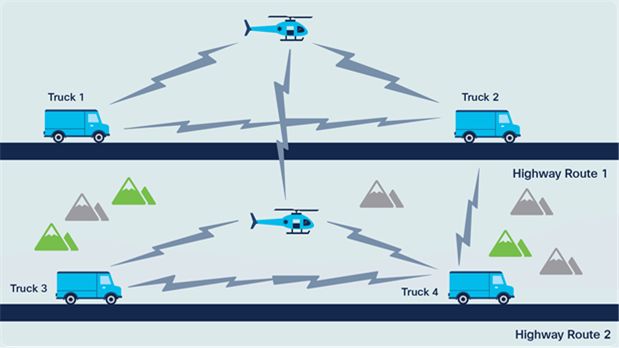
Physical mesh topography
The network in Figure1 is a voice, video, and data network between moving vehicles that consists of both ground and air vehicles. Hence the network is mobile, and it is a peer-to-peer mesh that changes as topographical obstructions are encountered. It is put together “on the fly.” This is where we get the term mobile ad hoc network, or MANET for short.
In the scenario shown in the figure, all four trucks always have connectivity with the helicopters that are flying over the same road. The two helicopters always have line of sight and will always have a connection with each other. The trucks may even be able to connect to the other helicopter or a truck on the opposite road when conditions are favorable.
Here we see that the path between trucks 1 and 3 is completely blocked. The path between trucks 2 and 4 is about to be blocked.
Our existing routing protocols, such as Open Shortest Path First version 3 (OSPFv3) and Enhanced Interior Gateway Routing Protocol (EIGRP), need to adjust their path metrics very quickly to maintain a cohesive operational network. The routing protocols also need a way to get that information from the radios, which requires a radio-to-router protocol that is delivered by Cisco® Radio Aware Routing in the form of two open protocols that we will discuss here.
MANETs are emerging as a means for delivering the benefits of IP networking to users operating beyond the reach of a fixed network. In MANETs, mobile nodes associate on an extemporaneous or ad hoc basis (refer to Figures 1 and 2). Ad hoc networks have numerous distinguishing characteristics when compared to conventional networking solutions:
● Self-forming: Nodes that come within radio range of each other can establish a network association without any preconfiguration or manual intervention.
● Self-healing: Nodes can join or leave rapidly without affecting the operation of the remaining nodes.
● No infrastructure: In a MANET, mobile nodes form their own network and essentially become their own infrastructure.
● Peer to peer: Traditional networks typically support end systems operating in client-server mode. In a MANET, mobile nodes can communicate and exchange information without prior arrangement and without reliance on centralized resources.
● Predominantly wireless: Historically, networks have been mostly wired and enhanced or extended through wireless access. The MANET environment is essentially wireless but can be extended to support wired resources.
● Highly dynamic: Mobile nodes are in continuous motion and ad hoc networking topologies are constantly changing.
Collectively, these characteristics enable MANETs to deliver timely information to a new and underserved class of users. Ad hoc networking solutions can be applied to virtually any scenario that involves a cadre of highly mobile users or platforms (which may include stationary devices as well), a strong need to share IP-based information, and an environment in which fixed infrastructure is impractical, impaired, or impossible.
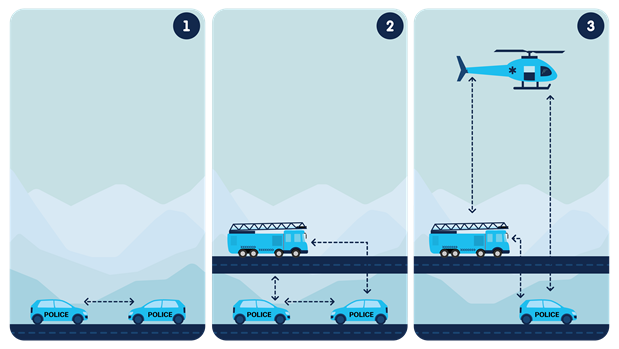
Ad hoc networks form as nodes come within range
MANETs deliver a compelling advantage wherever highly mobile users, unsupported by fixed infrastructure, need to share IP-based information. Specific benefits include:
● Superior information sharing at all levels, enabling improved situational awareness, a clearer understanding of the leader’s intent, and the ability for remote users to self-synchronize.
● Self-forming, self-healing operation, which facilitates deployment and minimizes the need for manual configuration and intervention.
● Multihop networking, which extends network coverage and provides redundant paths for increased resilience.
● Ability to operate with or without connectivity to a centralized network.
● Serving as a key enabler for new applications, such as vehicle-to-vehicle networking, intelligent transportation systems, sensor networking, telemetry monitoring, and more.
MANET technology poses numerous challenges compared to most currently deployed mobile networking solutions. For example, many TCP/IP applications are based on a client-server model in which a centralized manager controls operations. In a MANET, access to centralized resources is likely to be unavailable at the precise moment the resources are needed. Therefore, ad hoc network applications must operate on a self-configuring, peer-to-peer basis.
In addition, many network services, such as Authentication, Authorization, and Accounting (AAA), security, DNS, and application acceleration (to name a few), also rely on centralized or strategically concentrated servers or appliances. In a MANET, such services must be virtualized and distributed, so that each mobile node has access to required functions without the need for reach-back to remote servers.
MANET technology also poses hardware and platform challenges because many of today's networking devices must be optimized from a size, weight, and power perspective. In the peer-to-peer world, anybody or anything that moves can potentially be a wireless networking node. MANETs thus require a variety of platforms ranging from traditional rackmount to vehicle-based, to hand-carried or wearable, with all offering equivalent network services.
Routing and scalability are critical factors in ad hoc networks. Concerns about the speed with which mobile nodes can join or leave the network, the prospect of large numbers of peers and link updates, and the overhead associated with different protocols have led to the development of both new protocols—such as Optimized Link State Routing (OLSR) and Dynamic MANET On-demand (DYMO)—and ad hoc-related optimizations to existing and proven protocols—such as OSPFv3 and EIGRP.
The most fundamental problem facing those who develop, deploy, or use MANETs has been how best to merge two very different worlds—IP routing and mobile radio—while taking advantage of the strengths of each. In ad hoc networks, mobile nodes typically communicate over wireless radio networks, where bandwidth is at a premium. Radio link quality can vary suddenly and dramatically because of factors such as noise, fading, interference, and power fluctuation. In such dynamic environments, Layer 3 IP routing issues such as network convergence, route-cost calculation, and congestion avoidance can become highly problematic.
The seven-layer architectural model used in traditional networking assumes that each layer is unaffected by, and essentially blind to, whatever happens at any other layer. However, in ad hoc networks the efficiency of Layer 3 processes is directly related to lower-layer events. Consequently, the notion of using cross-layer feedback mechanisms has gained significant momentum. For example, cross-layer feedback can enable Layer 1 and Layer 2 intelligence to influence and optimize Layer 3 routing decisions.
Radio Aware Routing (RAR): Dynamic Link Exchange Protocol—RFC 8175
DLEP is a control protocol between a router and a DLEP-enabled radio modem. The DLEP message exchange between the router and radio allows the radio to tell the router about the link quality. This is somewhat analogous to the way the bar icon on your cell phone tells you about your Wi-Fi or LTE signal quality.

A radio link that implements DLEP between the router and its radio modem
How does DLEP help?
● Without DLEP there are two equal-cost paths to any unadjusted routing protocol.
● With DLEP, routing metrics can be adjusted in real time to favor the best path.
● With DLEP, the radio network conditions reported can also be used in the router’s quality-of-service (QoS) traffic shaping decisions.
● With DLEP, we have neighbor up/down status.

Unequal-cost paths
Atmospheric conditions and interference will ultimately favor one band over the other. While this example was simplified by considering only point-to-point technology, DLEP is focused more on radio mesh environments.
It is also important to note that as a protocol, DLEP evolved over approximately seven years, beginning in 2010, had 29 draft RFC releases, and was ratified in June 2017 as RFC 8175. Early draft versions of DLEP used only User Datagram Protocol (UDP) messages between the router and the connected radio. Today, RFC 8175 Section 11 states the following:
● DLEP defines two protocol units used in two different ways: Signals and Messages. Signals are only used in the Discovery mechanism and are carried in UDP datagrams. Messages are used bidirectionally over a TCP connection between the participants, in the Session Initialization, In-Session, and Session Termination states.
This means that some early “DLEP radios,” which cannot be upgraded to RFC 8175 compliance, may be incompatible with current versions of Cisco IOS® XE.
Other very important DLEP facts quoted from RFC 8175
15.14. DLEP Well-Known Port
IANA has assigned the value 854 in the "Service Name and Transport Protocol Port Number Registry" found at <https://www.iana.org/assignments/service-names-port-numbers/> for use by "DLEP", as defined in this document. This assignment is valid for TCP and UDP.
15.15. DLEP IPv4 Link-Local Multicast Address
IANA has assigned the IPv4 multicast address 224.0.0.117 in the registry found at <https://www.iana.org/assignments/multicast-addresses> for use as "DLEP Discovery".
15.16. DLEP IPv6 Link-Local Multicast Address
IANA has assigned the IPv6 multicast address FF02:0:0:0:0:0:1:7 in the registry found at <https://www.iana.org/assignments/ipv6-multicast-addresses> for use as "DLEP Discovery".
Radio Aware Routing (RAR): PPPoE Extensions for Credit Flow and Link Metrics – RFC 5578
Radio Aware Routing takes advantage of the functions defined in RFC 5578, which Cisco authored. RFC 5578 is an IETF standard that defines PPPoE extensions for Ethernet-based communications between a router and a device such as a mobile radio that operates in a variable-bandwidth environment and has limited buffering capabilities. These extensions provide a PPPoE session-based mechanism for sharing radio network status such as link quality metrics and establishing flow control between a router and an RFC 5578-capable radio.
Cisco Radio Aware Routing (RAR) using RFC 5578 is specifically targeted at routing over directional radio networks. Directional radio networks appear to the router as a series of point-to-point connections (refer to Figure 5).
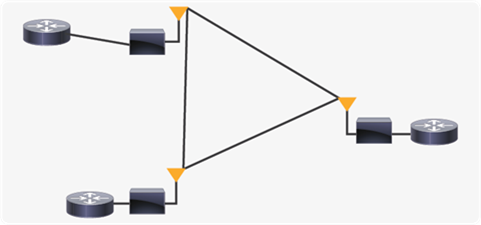
Directional point-to-point radio network
An RFC 5578 radio initiates a Layer 2 PPPoE session with its adjacent router on behalf of every router and radio neighbor discovered in the network. These Layer 2 sessions are how radio network status for each neighbor link is reported to the router. The radio establishes the correspondence between each PPPoE session and each link to a neighbor (refer to Figure 6).
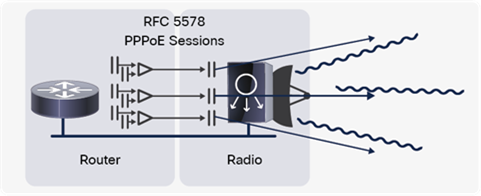
RFC 5578 PPPoE sessions
Whenever a PPPoE session is established, the router opens a PPP Link Control Protocol (LCP) session with the corresponding neighbor to negotiate PPP options (refer to Figure 7). When the PPP LCP process is complete, the PPP IP Control Protocol (IPCP) initiates an exchange of Layer 3 parameters between neighbor nodes. After the IPCP exchange, PPP data starts to flow from router to router.
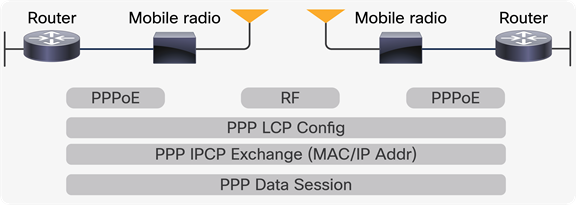
PPPoE session establishment
Taking advantage of RFC 5578 for a MANET
Effective networking in a MANET environment requires mechanisms by which routers and radios can interoperate efficiently, without impacting the operation of the radio network; radios can report status to routers for each link and each neighbor; routers can more readily recognize topology changes; and routers can use radio link information to optimize routing decisions. To address these needs, the Cisco RFC 5578 implementation incorporates the following features:
● PPPoE credit-based flow control: This extension to the PPPoE protocol allows a receiver to control the rate at which a sender can transmit data for each PPPoE session, minimizing the need for queuing in the radio.
● Neighbor up/down signaling: Cisco routers can use PPPoE session establishment or termination signals from the radio to update routing topologies.
Link quality metrics reporting: This PPPoE protocol extension enables a radio to report (or a router to query) link quality metric information. Cisco routers have been enhanced to allow the OSPFv3 and EIGRP routing protocols to factor RF link quality metrics into route cost calculations.
PPPoE credit-based flow control
The carrying capacity of each radio link can vary due to location changes or environmental conditions, and many radio transmission systems have limited buffering capabilities. To minimize the need for packet queuing in the radio, Radio Aware Routing employs a credit-granting mechanism that enables the radio to control the rate at which its partner router sends traffic.
When the PPPoE session is established, the radio can request a flow-controlled session. If the router acknowledges the request, all subsequent traffic must be flow controlled. If a flow-control session has been requested and cannot be supported by the router, the session is terminated. Typically, the radio initially grants credits during session discovery. When a device exhausts its credits, it must stop sending until additional credits are granted. Credits can be added incrementally over the course of a session. Implementing flow control on the PPPoE router-to-radio sessions also allows the use of fair queuing for each session.
Common benefit: Neighbor up/down signaling
MANETs are highly dynamic environments. Nodes may move in or out of radio range at a fast pace. Each time a node joins or leaves, the network topology must be updated by the routers. Routing protocols normally use timer-driven “hello” messages or neighbor timeouts to track topology changes, but for ad hoc network environments, reliance on these mechanisms can result in unacceptably slow convergence. RFC 5578-based, and RFC 8175-based solutions provide faster network convergence by using link status signals generated by the radio. The router infers a change in neighbor status based on the creation or termination of a PPPoE session by the radio.
In the router, the routing protocols (OSPFv3 and EIGRP) respond immediately to these signals by expediting formation of a new adjacency for a new neighbor or tearing down an existing adjacency if a neighbor is lost (refer to Figure 8).
For example, if a vehicle drives behind a building and loses its connection, the router immediately senses the loss and establishes a new route to the vehicle through neighbors that are not blocked. This high-speed network convergence is essential for minimizing dropped voice calls and disruptions to video sessions.
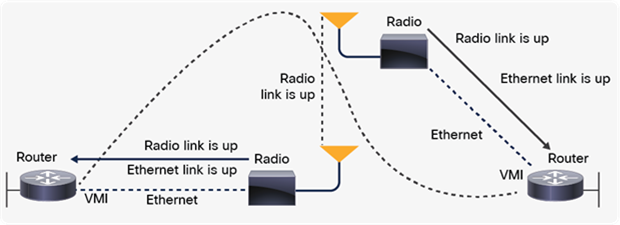
Neighbor up/down signaling
Common benefit: Link quality metrics
The quality of a radio link directly affects the throughput that router-to-router traffic can achieve. PPPoE and DLEP have been extended to provide a process by which a router can request—or a radio can report—link quality metric information. Cisco OSFPv3 and EIGRP implementations have been enhanced so that the route cost to a neighbor is dynamically updated based on metrics reported by the radio. This capability helps optimize route selection within a given set of radio links.
The routing protocols receive raw radio link data and compute a composite quality metric for each link. In computing these metrics, the following factors may be considered (depending on the routing protocol being used and the radio vendor's implementation of link metrics):
● Maximum Data Rate (MDR): The theoretical maximum data rate of the radio link.
● Current Data Rate (CDR): The current data rate achieved on the link.
● Latency: The transmission delay packets encounter, in milliseconds.
● Resources: A percentage (0 to 100) that can represent the remaining amount of a resource (such as battery power).
● Relative link quality: A numeric value (0 to 100) representing relative quality, with 100 being the highest quality.
Metrics can be weighted during the configuration process to emphasize or deemphasize characteristics when computing link cost. For example, if throughput is a particular concern, the current data rate metric could be weighted so that it is factored more heavily into the composite metric. Similarly, a metric that is of no concern can be omitted from the composite calculation.
Link metrics can change rapidly, often by very small degrees, possibly resulting in a flood of meaningless routing updates. In a worst-case scenario, the network would churn almost continuously as it struggled to react to minor variations in link quality. To alleviate this problem, Cisco provides a tunable dampening mechanism that allows you to configure threshold values based on the magnitude or timing of changes. Any metric change that falls below the threshold is ignored.
Common feature: Interfacing Layer 2 to Layer 3: The virtual multipoint interface
Both the Cisco RFC 5578 and Cisco RFC8175 implementations incorporate a Virtual Multipoint Interface (VMI) within Cisco IOS Software that aggregates all the per-neighbor sessions that communicate Layer 1 and Layer 2 radio-related information from the radio Ethernet connection to the IP layer within the router, where it can be used to influence or adjust networking processes.
The VMI maps these sessions to appear to Layer 3 routing protocols as a single point-to-multipoint, multiaccess, broadcast-capable network (refer to Figure 9). The VMI aggregation function also reduces the size of the internal database of the router and thus improves scalability and network convergence. In the case of RFC 5578, the VMI preserves the integrity of the PPPoE sessions on the radio side, helping ensure that each point-to-point connection can have its own QoS queue.
The VMI relays the link quality metric and neighbor up/down signaling from the radio to the routing protocols. Currently, VMI signals are used by EIGRP and OSPFv3.
Note: Cisco offers a bypass mode for PPPoE Extensions for Credit Flow and Link Metrics – RFC 5578 so that the VMI aggregation function can be enabled or disabled for multicast operations. Disabling the aggregation function provides full visibility to the router of each PPPoE session and each virtual interface. Using bypass mode may, of course, increase the size of the router database and thus may affect scalability and increase network convergence times. It is important to note, however, that network metric information and neighbor up/down signaling should not be affected.
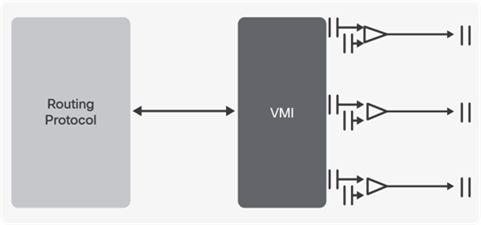
Cisco IOS Software VMI
Table 1 provides a concise comparison of the major technical characteristics of the two protocols used for Cisco Radio Aware Routing.
Table 1. Comparison of Radio Aware Routing protocols
| Feature |
||
| UDP for neighbor discovery, TCP for radio-to-router messages Transparent bridge on data path |
||
MANETs are emerging to deliver IP-based voice, video, and data to users who may be operating beyond the reach of traditional fixed network infrastructure. Ad hoc networking offers a compelling advantage for many environments but also poses significant challenges. Foremost among these challenges is the need to merge IP routing and mobile radio technologies efficiently.
Today, radios have three possibilities:
● No radio-router interaction
● RFC-5578 – PPP over Ethernet (PPPoE) Extensions for Credit Flow and Link Metrics
● RFC-8175 – Dynamic Link Exchange Protocol (DLEP)
The actual choice of protocols depends largely on the radio vendor and the intended applications and optimization of their devices.
RFC 5578 and RFC 8175 provide an effective, cross-layer mechanism for communicating radio network status to IP routers—RFC 5578 primarily for TDMA-style radios and RFC 8175 primarily for multiaccess shared media radios in a topology that is very similar to Wi-Fi.
In 2007, Cisco delivered the industry's first Radio Aware Routing implementation for the Cisco 3200 Series Rugged Integrated Services Routers and Cisco 2800 Series and 3800 Series Integrated Services Routers. RFC 4938 was an earlier version of RFC 5578. Cisco has also partnered with major radio vendors to facilitate their radio-side implementations of this industry standard.
Initially, Cisco Radio Aware Routing was developed for military applications. The Cisco Radio Aware Routing solution allows network-based applications and information to be quickly and reliably transported over directional radio links, and hence it has value for other applications that depend upon fast convergence and optimal route selection to help ensure satisfactory delivery of mission-critical, delay-sensitive traffic (refer to Figure 10).
Today Cisco IOS XE delivers Radio Aware Routing in Cisco IOS XE Release 17.8.1 under the Network Advantage license.
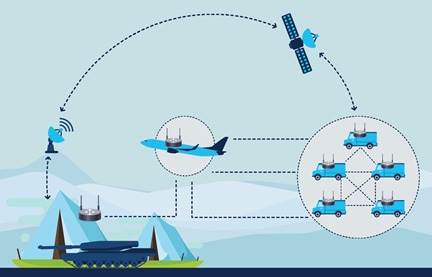
Radio Aware Routing for military applications
Learn more about MANET protocols:
● https://datatracker.ietf.org/doc/html/rfc8175
● https://datatracker.ietf.org/doc/rfc8175/
● https://datatracker.ietf.org/doc/html/rfc5578
View Cisco Radio Aware Routing At-a-Glance
Read Cisco Radio Aware Routing blog
Review Cisco Embedded Service 6300 Series Software Configuration Guide